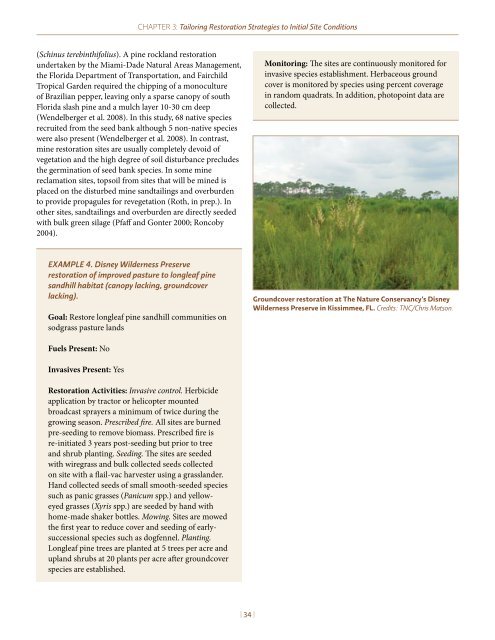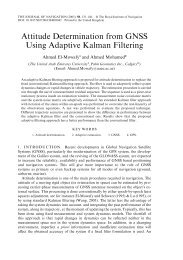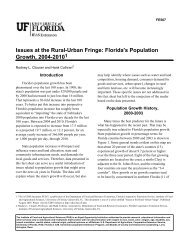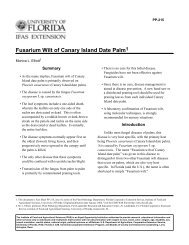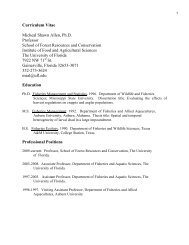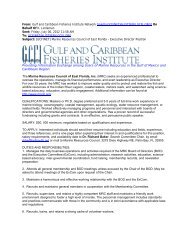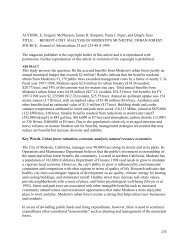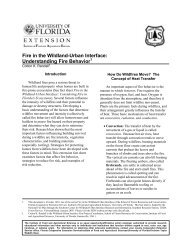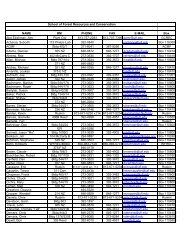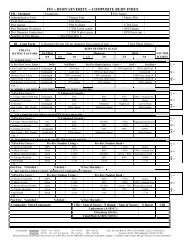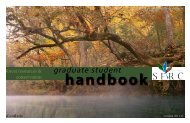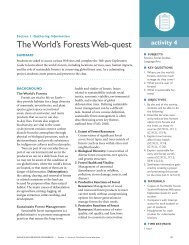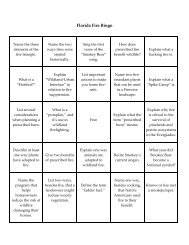Chapter 3: Tailor<strong>in</strong>g <strong>Restoration</strong> Strategies to Initial Site Conditions(Sch<strong>in</strong>us tereb<strong>in</strong>thifolius). A p<strong>in</strong>e rockland restorationundertaken by <strong>the</strong> Miami-Dade Natural Areas Management,<strong>the</strong> Florida Department <strong>of</strong> Transportation, and FairchildTropical Garden required <strong>the</strong> chipp<strong>in</strong>g <strong>of</strong> a monoculture<strong>of</strong> Brazilian pepper, leav<strong>in</strong>g only a sparse canopy <strong>of</strong> southFlorida slash p<strong>in</strong>e and a mulch layer 10-30 cm deep(Wendelberger et al. 2008). In this study, 68 native speciesrecruited from <strong>the</strong> seed bank although 5 non-native specieswere also present (Wendelberger et al. 2008). In contrast,m<strong>in</strong>e restoration sites are usually completely devoid <strong>of</strong>vegetation and <strong>the</strong> high degree <strong>of</strong> soil disturbance precludes<strong>the</strong> germ<strong>in</strong>ation <strong>of</strong> seed bank species. In some m<strong>in</strong>ereclamation sites, topsoil from sites that will be m<strong>in</strong>ed isplaced on <strong>the</strong> disturbed m<strong>in</strong>e sandtail<strong>in</strong>gs and overburdento provide propagules for revegetation (Roth, <strong>in</strong> prep.). Ino<strong>the</strong>r sites, sandtail<strong>in</strong>gs and overburden are directly seededwith bulk green silage (Pfaff and Gonter 2000; Roncoby2004).Monitor<strong>in</strong>g: The sites are cont<strong>in</strong>uously monitored for<strong>in</strong>vasive species establishment. Herbaceous groundcover is monitored by species us<strong>in</strong>g percent coverage<strong>in</strong> random quadrats. In addition, photopo<strong>in</strong>t data arecollected.EXAMPLE 4. Disney Wilderness Preserverestoration <strong>of</strong> improved pasture to longleaf p<strong>in</strong>esandhill habitat (canopy lack<strong>in</strong>g, groundcoverlack<strong>in</strong>g).Goal: Restore longleaf p<strong>in</strong>e sandhill communities onsodgrass pasture lands<strong>Groundcover</strong> restoration at The Nature Conservancy’s DisneyWilderness Preserve <strong>in</strong> Kissimmee, FL. Credits: TNC/Chris Matson.Fuels Present: NoInvasives Present: Yes<strong>Restoration</strong> Activities: Invasive control. Herbicideapplication by tractor or helicopter mountedbroadcast sprayers a m<strong>in</strong>imum <strong>of</strong> twice dur<strong>in</strong>g <strong>the</strong>grow<strong>in</strong>g season. Prescribed fire. All sites are burnedpre-seed<strong>in</strong>g to remove biomass. Prescribed fire isre-<strong>in</strong>itiated 3 years post-seed<strong>in</strong>g but prior to treeand shrub plant<strong>in</strong>g. Seed<strong>in</strong>g. The sites are seededwith wiregrass and bulk collected seeds collectedon site with a flail-vac harvester us<strong>in</strong>g a grasslander.Hand collected seeds <strong>of</strong> small smooth-seeded speciessuch as panic grasses (Panicum spp.) and yelloweyedgrasses (Xyris spp.) are seeded by hand withhome-made shaker bottles. Mow<strong>in</strong>g. Sites are mowed<strong>the</strong> first year to reduce cover and seed<strong>in</strong>g <strong>of</strong> earlysuccessionalspecies such as dogfennel. Plant<strong>in</strong>g.Longleaf p<strong>in</strong>e trees are planted at 5 trees per acre andupland shrubs at 20 plants per acre after groundcoverspecies are established.| 34 |
Chapter 4Important Considerations for <strong>Groundcover</strong> Establishment<strong>Restoration</strong> is a long, complex process that should<strong>in</strong>volve plann<strong>in</strong>g, site assessment, referencecommunity selection, consideration <strong>of</strong> alternativerestoration strategies, implementation <strong>of</strong> restorationactivities, and monitor<strong>in</strong>g. These efforts must be site-specificso that <strong>the</strong>y identify and address <strong>the</strong> sources <strong>of</strong> degradationand ecological impairments that are unique to each site. Forthis reason, <strong>the</strong>re is no simple, prepared restoration plan thatwill work on every site.The sheer magnitude <strong>of</strong> decisions which must be maderegard<strong>in</strong>g which activities to employ and when to <strong>in</strong>itiateeach can be overwhelm<strong>in</strong>g. Practitioners need to decidewhich site conditions need to be altered and <strong>the</strong>n select<strong>the</strong> most appropriate site preparation techniques to make<strong>the</strong>se changes; determ<strong>in</strong>e if <strong>in</strong>vasive species control isneeded and if so which techniques would most effectivelyaddress <strong>the</strong> species present; decide whe<strong>the</strong>r to rely onnatural recruitment or to actively pursue direct seed<strong>in</strong>g oroutplant<strong>in</strong>g; if necessary, decide where and how to obta<strong>in</strong>plant material and what equipment is needed to acquireand to distribute <strong>the</strong> plant material; and decide whe<strong>the</strong>rprescribed burn<strong>in</strong>g would be appropriate, and if so, how<strong>of</strong>ten. Fur<strong>the</strong>rmore, <strong>the</strong> time <strong>of</strong> year that each <strong>of</strong> <strong>the</strong>seactivities takes place and <strong>the</strong> order<strong>in</strong>g <strong>of</strong> activities is <strong>of</strong>crucial importance <strong>in</strong> determ<strong>in</strong><strong>in</strong>g <strong>the</strong> ultimate degree <strong>of</strong>restoration success. Although a lot <strong>of</strong> <strong>in</strong>formation on <strong>the</strong>setopics exists <strong>in</strong> <strong>the</strong> published literature, most studies addressonly 1 or 2 issues at 1 or 2 locations, and do not look at <strong>the</strong>entire restoration process holistically.We decided that distill<strong>in</strong>g exist<strong>in</strong>g <strong>in</strong>formation fromnumerous studies that addressed a variety <strong>of</strong> issues atmultiple sites across <strong>the</strong> Sou<strong>the</strong>ast could be a usefulendeavor. By <strong>in</strong>tegrat<strong>in</strong>g restoration plant<strong>in</strong>g and seed<strong>in</strong>gresearch from numerous projects <strong>in</strong>to a s<strong>in</strong>gle analysis, weexam<strong>in</strong>ed <strong>the</strong> relative importance <strong>of</strong> <strong>the</strong> myriad factorsthat <strong>in</strong>fluence restoration success across studies. Us<strong>in</strong>gclassification and regression trees (CART), we identifiedwhich site preparation and plant<strong>in</strong>g techniques were mostcritical to understory restoration success (Trusty andOber, <strong>in</strong> press). The follow<strong>in</strong>g simple suggestions derivedfrom <strong>the</strong>se analyses should <strong>in</strong>crease <strong>the</strong> survivorship <strong>of</strong>outplant<strong>in</strong>gs and <strong>in</strong>crease <strong>the</strong> establishment rate <strong>of</strong> nativeseeds dur<strong>in</strong>g restoration efforts.Outplant<strong>in</strong>gThe factors we considered <strong>in</strong> our analyses <strong>in</strong>cluded plant<strong>in</strong>gseason, whe<strong>the</strong>r outplant<strong>in</strong>gs were established <strong>in</strong> <strong>in</strong>tactor severely degraded habitat, use <strong>of</strong> 5 different site prepactivities, presence <strong>of</strong> an exist<strong>in</strong>g canopy, whe<strong>the</strong>r plant<strong>in</strong>gscame from on-site or <strong>of</strong>f-site and from habitats similar to ordifferent from <strong>the</strong> restoration site, and whe<strong>the</strong>r irrigation,fertilization, or burn<strong>in</strong>g occurred after plant<strong>in</strong>g.Our first recommendation is that careful considerationbe given to <strong>the</strong> tim<strong>in</strong>g <strong>of</strong> outplant<strong>in</strong>g. For restoration siteslocated <strong>in</strong> forests <strong>of</strong> <strong>the</strong> temperate Sou<strong>the</strong>ast, seed<strong>in</strong>g andplant<strong>in</strong>g should occur dur<strong>in</strong>g <strong>the</strong> dormant season, preferablylate fall or w<strong>in</strong>ter (November through February). The meansurvivorship <strong>of</strong> outplant<strong>in</strong>gs established at sites dur<strong>in</strong>gspr<strong>in</strong>g was 22 percentage po<strong>in</strong>ts lower than <strong>the</strong> collectivegroup <strong>of</strong> fall, w<strong>in</strong>ter, and summer planted sites (46% vs. 68%survivorship). However, <strong>in</strong> subtropical central and southFlorida, establish<strong>in</strong>g outplant<strong>in</strong>gs dur<strong>in</strong>g <strong>the</strong> summer (<strong>the</strong>season when ample ra<strong>in</strong>fall is most predictable) leads tohigher outplant survivorship.Second, it is recommended that practitioners restor<strong>in</strong>gnative groundcover species to p<strong>in</strong>e plantation sites ma<strong>in</strong>ta<strong>in</strong>some level <strong>of</strong> canopy coverage dur<strong>in</strong>g <strong>the</strong> restorationprocess.Third, although implement<strong>in</strong>g a prescribed fire regime <strong>in</strong>many forested ecosystems <strong>in</strong> <strong>the</strong> Sou<strong>the</strong>ast is important tooverall project success, it is recommended that burn<strong>in</strong>g notbe <strong>in</strong>itiated prior to 2 years after outplant<strong>in</strong>g. Plants thatwere burned earlier after outplant<strong>in</strong>g had lower survivorshipthan those that were not burned until later.F<strong>in</strong>ally, consideration should be given to how closely <strong>the</strong>source habitat from which outplant<strong>in</strong>gs were obta<strong>in</strong>edmatches those <strong>of</strong> <strong>the</strong> restoration site. Survivorship <strong>of</strong>outplant<strong>in</strong>gs that used materials obta<strong>in</strong>ed from similarsource habitat was significantly higher than survivorship <strong>of</strong>outplant<strong>in</strong>gs that used materials from dissimilar habitat.| 35 |


